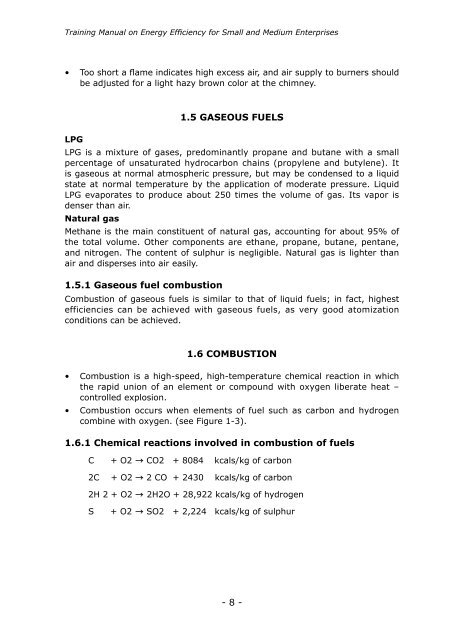Training Manual on Energy Efficiency - APO Asian Productivity ...
Training Manual on Energy Efficiency - APO Asian Productivity ...
Training Manual on Energy Efficiency - APO Asian Productivity ...
Create successful ePaper yourself
Turn your PDF publications into a flip-book with our unique Google optimized e-Paper software.
<str<strong>on</strong>g>Training</str<strong>on</strong>g> <str<strong>on</strong>g>Manual</str<strong>on</strong>g> <strong>on</strong> <strong>Energy</strong> <strong>Efficiency</strong> for Small and Medium Enterprises<br />
• Too short a flame indicates high excess air, and air supply to burners should<br />
be adjusted for a light hazy brown color at the chimney.<br />
LPG<br />
1.5 GASEOUS FUELS<br />
LPG is a mixture of gases, predominantly propane and butane with a small<br />
percentage of unsaturated hydrocarb<strong>on</strong> chains (propylene and butylene). It<br />
is gaseous at normal atmospheric pressure, but may be c<strong>on</strong>densed to a liquid<br />
state at normal temperature by the applicati<strong>on</strong> of moderate pressure. Liquid<br />
LPG evaporates to produce about 250 times the volume of gas. Its vapor is<br />
denser than air.<br />
Natural gas<br />
Methane is the main c<strong>on</strong>stituent of natural gas, accounting for about 95% of<br />
the total volume. Other comp<strong>on</strong>ents are ethane, propane, butane, pentane,<br />
and nitrogen. The c<strong>on</strong>tent of sulphur is negligible. Natural gas is lighter than<br />
air and disperses into air easily.<br />
1.5.1 Gaseous fuel combusti<strong>on</strong><br />
Combusti<strong>on</strong> of gaseous fuels is similar to that of liquid fuels; in fact, highest<br />
efficiencies can be achieved with gaseous fuels, as very good atomizati<strong>on</strong><br />
c<strong>on</strong>diti<strong>on</strong>s can be achieved.<br />
1.6 COMBUSTION<br />
• Combusti<strong>on</strong> is a high-speed, high-temperature chemical reacti<strong>on</strong> in which<br />
the rapid uni<strong>on</strong> of an element or compound with oxygen liberate heat –<br />
c<strong>on</strong>trolled explosi<strong>on</strong>.<br />
• Combusti<strong>on</strong> occurs when elements of fuel such as carb<strong>on</strong> and hydrogen<br />
combine with oxygen. (see Figure 1-3).<br />
1.6.1 Chemical reacti<strong>on</strong>s involved in combusti<strong>on</strong> of fuels<br />
C + O2 CO2 + 8084 kcals/kg of carb<strong>on</strong><br />
2C + O2 2 CO + 2430 kcals/kg of carb<strong>on</strong><br />
2H 2 + O2 2H2O + 28,922 kcals/kg of hydrogen<br />
S + O2 SO2 + 2,224 kcals/kg of sulphur<br />
- 8 -
















